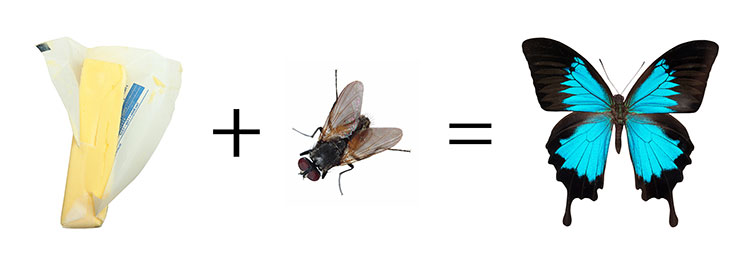D2: Making A Longer Word
1. Overview
Blend a one-syllable word and a two-syllable word into a longer compound word. This activity is very similar to the previous one, Making Compound Words (D1). The difference is that the compound words in this activity are made up of one one-syllable word and one two-syllable word. Because the words are longer, the child’s memory skills will be challenged more.
butter + fly = butterfly
2. Materials
↑ Top3. Activity
Video: How to play Making A Longer Word
Say two words for your child, a one-syllable word and a two-syllable word, that can be combined to form a three-syllable compound word. You will put a significant pause (one second long) between the two smaller words. Then tell him to put the two short words together into a longer word.
Adult: You did a good job putting two short words together to make a new word. Now I’m going to say two words that are a little longer. I want you to listen and put the words together to make one long word. Let me show you how: sand [1-second pause] castle. What word? Sandcastle. Now you do it. Listen: sand [pause] castle. What word? Child: Sandcastle! Adult: Good job! Let’s do another one. Listen: neighbor [pause] hood. What’s the word? Child: Neighborhood!Go through the other words in the word list until your child stops paying attention. You can continue the activity at your next session. NOTE: Hand motions (as demonstrated in the video) are an option for this activity. Another way to use hand gestures is to face the child and extend the fist of your right hand in front of you as you say the first word. Next, extend the fist of your left hand in front of you while saying the last word. Leave a little space between your two fists. Then bring your fists together when you ask “What word? ” ↑ Top
4. Confidence Builder
If the child struggles, put a shorter pause between the two one-syllable words as you say them. Then gradually lengthen the pause until the two words are said with a full one-second pause between them. ↑ Top5. Extension
Extension A: If your child has mastered the art of putting together three-syllable compound words, challenge him with some four-syllable compound words. Here is a list of words you can use: Extension B: Say the first part of a compound word, and ask the child to give you the last part. There will be multiple possible answers that are correct. For example, for the first part snow, the child could say snowman, snowball, or snowflake. You may need to give a hint by pointing, gesturing, or acting out a possible answer. For example, you could say the word eye and then point to a ball (for eyeball), to your eyebrow or to your eyelashes. ↑ Top6. Variation
This is a very “portable” game. Play in the car while you’re running errands or in the kitchen while your child helps you fix dinner! ↑ Top7. Small Groups (2-5 children)
Lesson Objective: Children will hear two spoken words of one syllable or more and combine them orally to make a new, multi-syllable word with its own meaning. GELDS (Georgia Early Learning & Development Standards): CLL6.4e Georgia Standards of Excellence: ELAGSEKRF2.b Common Core State Standards: CCSS.ELA-LITERACY.RF.K.2.B Adaptation: Read the main activity, watch the video, and follow the instructions above, with the following changes: Teach the children hand gestures to illustrate the combining of two words into one new word. For example, have children hold out their fists, several inches apart, to represent each one-syllable word as they repeat the words. Then have them move their two fists together and say the new compound word. Reinforcement: Use the word list to quiz the group on making compound words. Use the motions listed below for the children to use as a way to respond when they know the answer:- Round 1: Clap (when you know the answer)
- Round 2: Snap or tap your fingers
- Round 3: Pat your head
Leave a Reply
